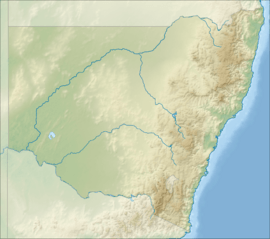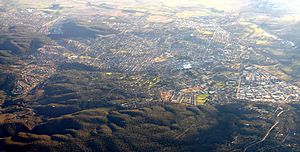Queanbeyan Nature Reserve facts for kids
Quick facts for kids Queanbeyan Nature ReserveNew South Wales |
|
|---|---|
|
IUCN Category IV (Habitat/Species Management Area)
|
|
| Nearest town or city | Queanbeyan |
| Established | March 1989 |
| Area | 0.67 km2 (0.3 sq mi) |
| Managing authorities | NSW National Parks and Wildlife Service |
| Website | Queanbeyan Nature Reserve |
| See also | Protected areas of New South Wales |
The Queanbeyan Nature Reserve is a special protected area in New South Wales, Australia. It is located about 4 kilometers (2.5 miles) west of the city of Queanbeyan. This reserve covers about 67 hectares (166 acres) of land.
The reserve is very important because it protects rare types of natural areas. These include Natural Temperate Grassland and grassy Box-Gum Woodland. It is also home to two endangered species: the Button wrinklewort plant and the Golden Sun Moth. The NSW National Parks and Wildlife Service looks after this reserve.
Contents
History of the Reserve
The land around Queanbeyan has long been the traditional home of the Ngunnawal people. European settlers arrived in the 1820s. The town of Queanbeyan grew up near the Queanbeyan River. Before it became a reserve, this land was mostly used for grazing sheep and cattle. You can still see signs of early settlement, like old pine trees and the site of a former house.
How the Park Was Created
The northern part of the Queanbeyan Nature Reserve was officially protected in March 1989. Before that, it was managed by the Queanbeyan City Council. It even included a former rubbish tip! This section is next to a railway line, horse paddocks, and houses.
In 2004, the NSW Government added a larger southern section to the reserve. This new part is about 64 hectares (158 acres). It is separated from the northern section by a short distance. This area used to be managed by the NSW Department of Housing.
Amazing Ecosystems
The Queanbeyan Nature Reserve protects two very important and rare types of natural areas. These are called "ecological communities."
Natural Temperate Grasslands
Natural Temperate Grasslands are special places found in the Southern Tablelands of NSW. They are usually open areas with no trees. Instead, they are full of different types of native grasses and other small plants. These grasslands grow in valleys and plains where the air can get very cold.
- Why they are endangered: Since European settlement in the 1830s, most of these grasslands have disappeared. They were cleared for farming, grazing, and building. Weeds also took over. Now, only about 3% of the original grasslands are left in good condition. Because of this, Natural Temperate Grassland is listed as an endangered community.
- What you can find here: The reserve has Wallaby-grass, Tall Speargrass, and Kangaroo Grass. You can also see beautiful flowers like Hoary Sunray and Blue Devil. Unfortunately, some weeds like St John's Wort and Serrated Tussock also grow here.
Box-Gum Woodland
Box-Gum Woodland is another important natural area protected in the reserve. This type of woodland is found in the tablelands and western slopes of NSW. It gets its name from the main trees that grow there: White Box, Yellow Box, and Blakely's Red Gum.
- Why they are endangered: Like the grasslands, Box-Gum Woodlands have been greatly reduced. Less than 1% of their original area remains. This is mainly due to land clearing for farms and pastures. Because so little is left, Box-Gum Woodland is listed as a critically endangered community.
- What you can find here: In the reserve's Box-Gum Woodland, you'll see Yellow Box and Blakely's Red Gum trees. There are also shrubs like Early Wattle and Sweet Bursaria. The ground is covered with native grasses and wildflowers, including different types of Wallaby Grasses and Kangaroo Grass. Weeds like St John's Wort and African Lovegrass are also present.
Special Plants
Button Wrinklewort
The Queanbeyan Nature Reserve is home to a large number of Button wrinklewort plants. In 1999, about 10,000 were counted. Now, there might be as many as 27,000!
- What it looks like: Button wrinklewort is a small plant that grows about 15 to 30 centimeters (6 to 12 inches) tall. It has many stems and produces small, yellow, clustered flowers in spring and summer.
- Where it lives: This plant usually grows in Natural Temperate Grasslands and Box-Gum Woodlands. It is found in south-east NSW and parts of Victoria. In NSW, it grows in areas like Goulburn and Canberra-Queanbeyan.
- Why it is endangered: Many of the places where Button wrinklewort used to grow have been lost or damaged. This is due to farming, building, weeds, and changes in fire patterns. Only 18 natural groups of these plants are known in NSW. Because of this, Button wrinklewort is listed as an endangered species.
Special Animals
Golden Sun Moth
The Golden Sun Moth is a medium-sized moth that flies during the day. Females have a wingspan of about 31 mm (1.2 inches), and males are about 34 mm (1.3 inches).
- Where it lives: In NSW, Golden Sun Moths are found in the area between Queanbeyan, Gunning, Young, and Tumut. They live in Natural Temperate Grasslands and grassy Box-Gum Woodlands. They especially like areas with Wallaby Grasses.
- Life cycle and behavior: The young moths (larvae) eat only the roots of wallaby grasses. Adult moths do not eat at all and only live for one to four days! They usually fly for about six to eight weeks in November and December. Male moths only fly when it's sunny and warm. Female moths rarely fly, but males can fly for longer distances.
- Why it is endangered: The places where Golden Sun Moths live have been greatly reduced and damaged. This is because their grassland and woodland homes have been cleared. If populations are separated by more than 200 meters, they are unlikely to meet and reproduce. This makes it hard for them to survive. Because of these threats, the Golden Sun Moth is listed as a critically endangered species.



